Results 1 to 10 of 14
Thread: My first Jnat. Is this a Kiita?
-
04-27-2017, 07:57 AM #1
 My first Jnat. Is this a Kiita?
My first Jnat. Is this a Kiita?
I'm new to Jnats and I'm in the process of buying my first. I was working on a restoration with dshaves and he brought this stone for me to try. Now, I've never had much of interest in Jnats. I've had a few Coticules that I liked okay, but mainly I like my Naniwas. This thing was in my house though, so I was eager to try it.
I decided to try it out on a 7/8 Wade & Butcher that I had just restored and finished on a Nani 12k the day before. This would give me a nice reference since it was just finished and shave tested. I gave it 30 laps on the Jnat with only water. The test shave was fantastic and a very noticeable improvement! He let me hold onto it and I've been experimenting with it all week with really good results. I've gotten the best results by raising a slurry and diluting down to pure water.
The seller that dshaves bought it from sold it as a Nakayama Namito Kiita Sumanagashi. I know that Nakayama is the mine and Kiita Means it's yellow, but I'm not sure what Namito and Sumanagashi mean. This also doesn't look like any of the other Kiitas that I've seen, due to the various colors and patterns. .
Any info on this stone or tips for using it would be very much appreciated.
Here's a few pics. The first is dry and the second is wet.
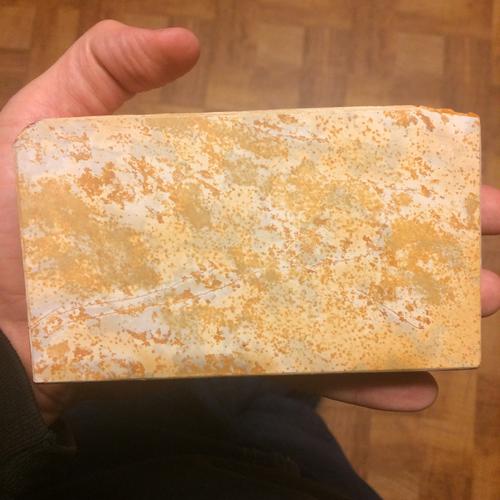
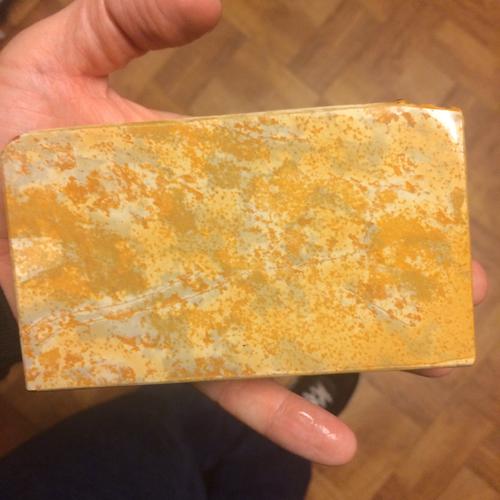
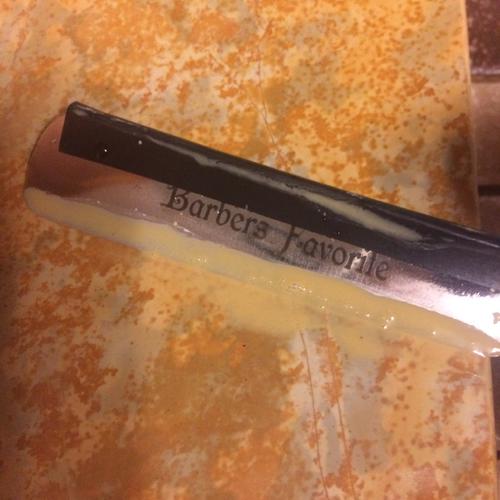
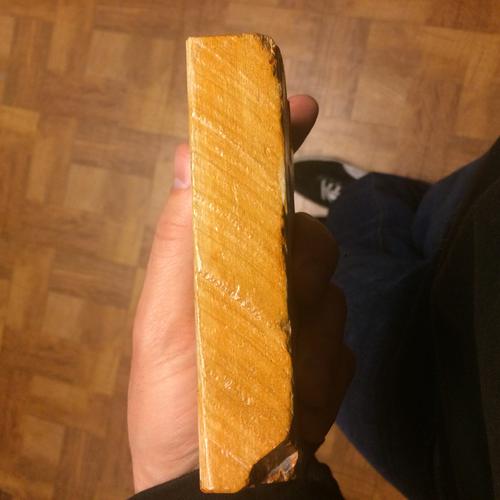
Last edited by BeJay; 04-27-2017 at 08:17 AM.
B.J.
-
04-27-2017, 08:09 AM #2

Namito is the strata, Suminagashi is the mottled pattern. You appear to have an excellent stone in your hand.
Sent from my iPhone using Tapatalk"Every normal man must be tempted at times to spit on his hands, hoist the black flag, and begin to slit throats." -H. L. Mencken
-
The Following User Says Thank You to sqzbxr For This Useful Post:
BeJay (04-27-2017)
-
04-27-2017, 02:16 PM #3Senior Member

- Join Date
- Jan 2015
- Location
- Apex NC
- Posts
- 535
Thanked: 90
Looks similar to the bottom of one of mine that I decided to lap and see what was there. I think under your Suminagashi pattern it looks like you might have a layer of Namazu. Mine is an excellent finisher on both sides, but the side that looks more like yours is a bit harder.
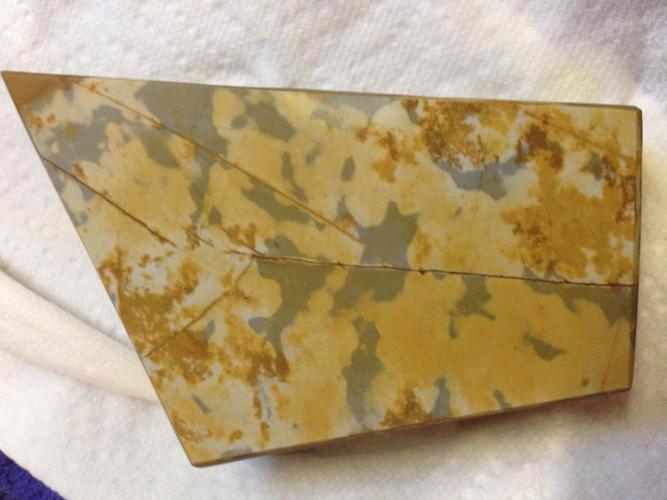
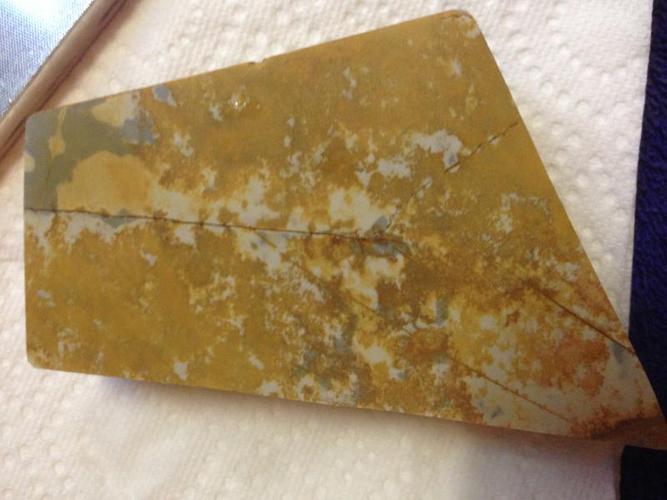
-
The Following User Says Thank You to rideon66 For This Useful Post:
BeJay (04-28-2017)
-
04-29-2017, 03:35 PM #4

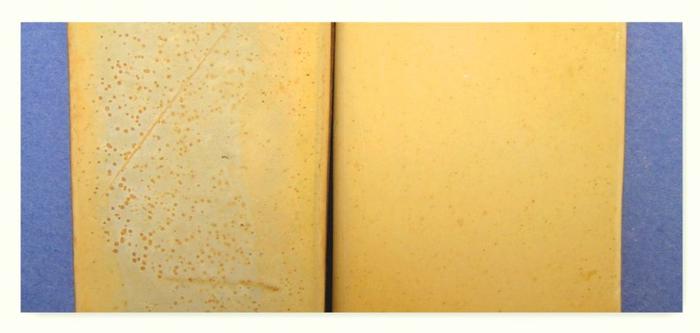
Jay
I like that size stone for hand held honing and it sounds like you are already getting good edges. The Namito layer is fairly deep in the mine scheme and your stone if from the Namito should be in the hardness range level 5++ range meaning that a bead of water will not sink into the stone for an hour or more, and that when lapping with a diamond plate the stone resists abrading. There are a lot of stones from the Kyoto mines that have yellow or similar light colors because of the yellow clay materials that were prevalent during the creation period. Kiita stones are usually predominately yellow with little bits of off color or a nashiji pear skin design. The large blotches of alternate colors or shades suggest a different strata to me.
My photo ^ of the two stones side by side both have yellow clay, the stone on the right is a kiita 5+from a Tomae layer/strata while the stone on the left has hints of yellow but is mostly gray and it is from a deeper part of the mine and from a layer of Suita and is a hardness 5+++ that just happens to have some yellow clay on the fringes and and greatly affected by the outer sides being banded by layers of mineral rich Kawa skin who's contents can taint the body of the stones adjacent surfaces.
The "classic" layer of kiita found only in the tomae strata are rare, and there really was only one kiita layer among the 40+ separate stacked one on top of the other tomae layers where it was found from mine to mine. These kiita stones were mostly in the hardness levels of 5 to 5++ and way softer then the gray tomae or green tomae layers. Kiita are so popular right now that the purity of any particular kiita stone is a flexible notion, meaning that just so it's yellow to some degree is all that matters to some sellers and users.
So much of choosing stones for razor, tool or knife honing is a matter of personal preference, touch and beauty drive us. The actual facts of mining were hardly documented in the Kyoto mines and the mines were mostly family operated businesses. The great majority of stones that you see when you walk in the door of a Kyoto or Tokyo stone shop are similar to the ones you saw yesterday. I believe that the really great cutting and performing stones were sold 100 or more years ago to temple and teahouse carpenters and master lacquer craftsmen, to sword polishers and the barbers of great status. We here, some of use privately feel the spirit of the stone, or admire their beauty as often mentioned in these posts. My favorite stone is a real feeling. We are looking at the stones that we deserve and that were left to us by the master craftsmen from past generations in Japan. They had first choice, we have second choice. Second choice tennen toishi are still pretty dam nice.
Alex
-
-
04-29-2017, 04:26 PM #5< Banned User >

- Join Date
- Oct 2016
- Location
- Saratoga, CA
- Posts
- 597
Thanked: 59
All your Kiita belong to us!

Then there is orange, or is that dark yellow?
Then some have a sulfur smell to them. Gotta watch out for those as they will begin to darken a carbon steel blade while you are honing. Plenty of variables.Last edited by Aerdvaark; 04-29-2017 at 04:43 PM.
-
04-29-2017, 10:34 PM #6

Here are some examples of kiita colors.
The first two stones/images are very pure Nakayama kiita, the real deal and difficult to just go out and buy though you occasionally run across them. They're really not as hard and fine as I'd like a tier-1 razor hone to be, but all can finish out a razor with clear water and light strokes. Some of the polish exceptionally well on clear water.
The third stone is a kiita that leans toward orange, and it has a steak of iro or red in it. Also very pure and hones like the others.
The fourth is what's sometimes called 'egg' kiita, it's a darker yellow with some brown in it. This one is a Maruka and it's a tier-1 razor hone. The brownish or 'egg' kiita are more likely to be harder and finer than the drop dead gorgeous yellow kiita. This stone is wet in the image and it appears darker than it does dry.
The last stone, a koppa, has a little blue in it that shifts the yellow toward green and is sometimes called a lime kiita.
There are of course a full spectrum of yellows and my images may look different on different monitors, but you should be able to see the difference between the classic color and some of the variations.
Cheers, Steve
-
The Following User Says Thank You to Steve56 For This Useful Post:
Iceni (04-29-2017)
-
04-30-2017, 12:02 AM #7

Alex,
The grit is out there ...
I did not want to quote your entire post, but I am not sure we don't have stones of the same quality today, they just aren't as pretty or regular.
When I first became interested in jnats, I of course did due diligence with Google-fu and came across an account of an American traveler in Japan who was a woodworker and at least knew his way around so to speak. Here's a paraphrase of his account as best I remember it.
'I was watching a carpenter at a temple/shrine/tea house plane the end of a conifer log. He would do 5-6 strokes with the plane, then pop the blade out and give it a few strokes on a rock that looked to me like a doorstop. What he was doing with the log is not easy to do.'
I kind of believe that the best grit is where you find it and probably always has been, sometimes it's pretty but most of the time isn't, at least any more. So while the stupendously beautiful and stupendously good stones may be practically extinct, there are still lots of stones around that good that are just ugly.
And I have an example, a full bench Nakayama asagi that's an unpleasant mix of blue and yellow. I would like to believe that all colors of nature are beautiful, but this one is not. It had been painted gray and blue then stripped by the seller so it had 'bald' spots - raw stone where there should have been skin - and it has every defect in the catalog - though none are toxic. It also makes some of the smoothest razor edges imagineable, marukas, Hatahoshis, Hatanakas, doesn't matter, it's as good as they are, but if I actually used it as a doorstop few people would notice.
Cheers, Steve
-
05-01-2017, 03:47 AM #8

Wow! So many great responses with tons of info for me to digest. Looks like I've got lots to read up on and research. Thank you all for pointing me in the right direction. Ive gone from having little to no interest in Jnats to eagerly learning all I can.
I've also got the chance to play with an Asagi this week. Should be fun.B.J.
-
05-01-2017, 05:17 AM #9

The Namito layer in Nakayama is quite consistent for razors & Asagi & Kiita colors are next door neighbours there.
Non blue or yellow stones from there are simply called Namito referring to the layer. eg belowLast edited by onimaru55; 05-07-2019 at 11:28 PM.
The white gleam of swords, not the black ink of books, clears doubts and uncertainties and bleak outlooks.
-
05-01-2017, 08:28 AM #10

Would love to feel that stone @onimaru55, perhaps this is its brother.

Nice show&tell fellas!As the time passes, so we learn.


 28Likes
28Likes LinkBack URL
LinkBack URL About LinkBacks
About LinkBacks







 Reply With Quote
Reply With Quote


